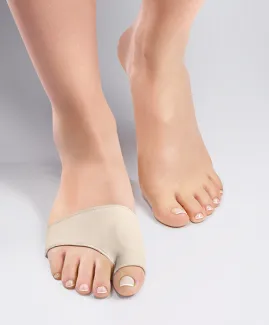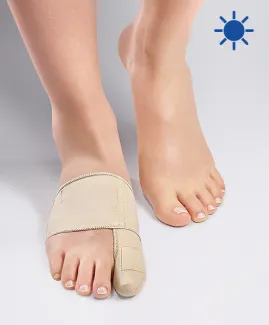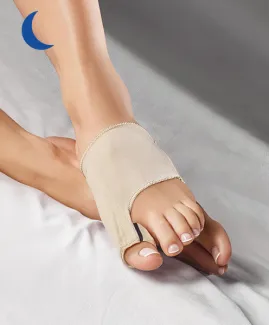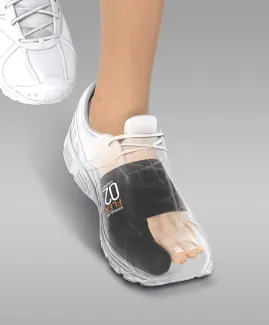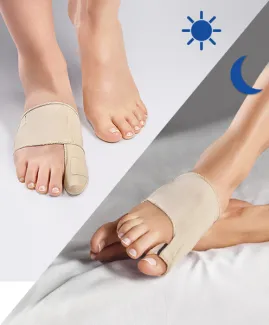
When and how long to wear a bunion corrector are two frequent questions when having a bunion.
This condition, also called hallux valgus, is a deviation of the first metatarsal inwards of the foot (compared to the central axis of the foot). A second deviation is observed: the first phalanx of the big toe is deviated outwards of the foot (compared to the central axis of the foot). This deformity causes a bony protrusion on the inner side of the foot, hence the name of ‘bunion’.
To avoid the worsening of symptoms related to bunions, EPITACT® has created washable and reusable bunion correctors, splints and silicone protections. Find out some recommendations about their use. For example, can you wear a bunion corrector at night? How long does it take for a bunion splint to correct the deviation? Find your answers in this article!
When to wear a bunion corrector?
The first objective if you have a bunion is to protect it and to reduce pain. At an early stage, bunion correctors can realign the big toe. At an advanced stage, bunion protectors provide pain relief in the shoes and orthopaedic insoles can help distribute pressure better. You would have understood it, there are two major categories of products: bunions correctors and protectors. So, when to wear a bunion corrector? Are there bunion correctors you can wear at night?
Bunion protectors
Wearing protector for bunions helps to protect the big toe deformity, but it does not correct it.
For people whose deformity makes the wearing of shoes uncomfortable and painful, solutions exist. For this reason, EPITACT® has developed a seamless and comfortable protection*. It can be worn in all types of shoes and avoids frictions and excessive pressure against the bunion.
Bunion correctors: which one during the day? Can I wear a bunion corrector at night?
Bunion correctors are useful in the early stages of the condition (the deviation is mild and the big toe still moves laterally). For this reason, move your toe and make sure it is still moving before choosing one of the devices mentioned below.
Devices for day
Day support braces are appropriate for daily activities whereas bunion night splints are to be worn during resting periods.EPITACT® has created a bunion brace for day* to correct the deformity during motion. It relieves pain, especially joint pain.
In addition, the bunion corrector for sport* was specifically created to realign the big toe during sports activities. It stays very well in place and optimises propulsion.
Devices for night
To answer your question, yes, you can wear a bunion corrector at night.
With its heat moldable reinforcements, the bunion splint for night* perfectly fits the shape of your foot and limits night pain. It also protects from contact pain between the bunion and the sheets, mattress, etc. it is thin and made of comfortable materials so it does not disturb your sleep.
In any case, a bunion is a deformity that cannot disappear over time. However, wearing protections is favourable because they are all intended to protect the bunion from friction and pressure.
How long to wear a bunion corrector?
As its name suggests, the corrective bunion splint for night* should be worn during resting periods or at night on a daily basis. The first 3 days, it is not recommended to wear it for more than 2 hours. After one month, the heat-moulding process should be renewed to increase the correction, if necessary. If you feel joint pain as soon as the first days of use or after several weeks, consult your podiatrist.
The day bunion corrector* is to wear during periods of activity on a daily basis too. To use during your sports activities, the bunion brace for sport* follows the same recommendations. Wearing a bunion support regularly is crucial to enjoy the benefits of its effectiveness.
During the first 10 days, wear it progressively (1 hour per day, 2 hours per day, then a few hours, etc.) and pull it backwards little by little to gently correct the big toe deformity. It can be worn as a preventive tool or over longer periods of treatment for hallux valgus. Lastly, the other EPITACT® solution; the bunion protector*, is dedicated to occasional use.
How long does it take for a bunion splint to correct the deformity?
Let us just remind you that bunions are permanent deformities. They can’t be totally corrected other than by surgery. However, wearing a bunion corrector or a bunion splint can help to realign the big toe. These claims are based on two clinical evaluations(1, 2): 79% of patients observed a realignment of their big toe after 1 month of use of the day bunion corrector and 92% with the night bunion splint.
Each protection has specific use recommendations, so do not hesitate to consult their respective instructions or seek advice from a health professional. You just discovered when to wear a bunion corrector and how long to use it. If you need help to choose the right device, click here.
*These solutions are class I medical devices that bear the CE marking under this regulation. Carefully the instructions before use. Manufacturer: Millet Innovation. 01/2022
Sources:
(1)Clinical evaluation conducted by Podyconcept in May 2011 on 39 patients with hallux valgus.
(2)Clinical evaluation conducted by Podyconcept in July 2015 on 15 patients with hallux valgus.
 Pharmacie
Pharmacie